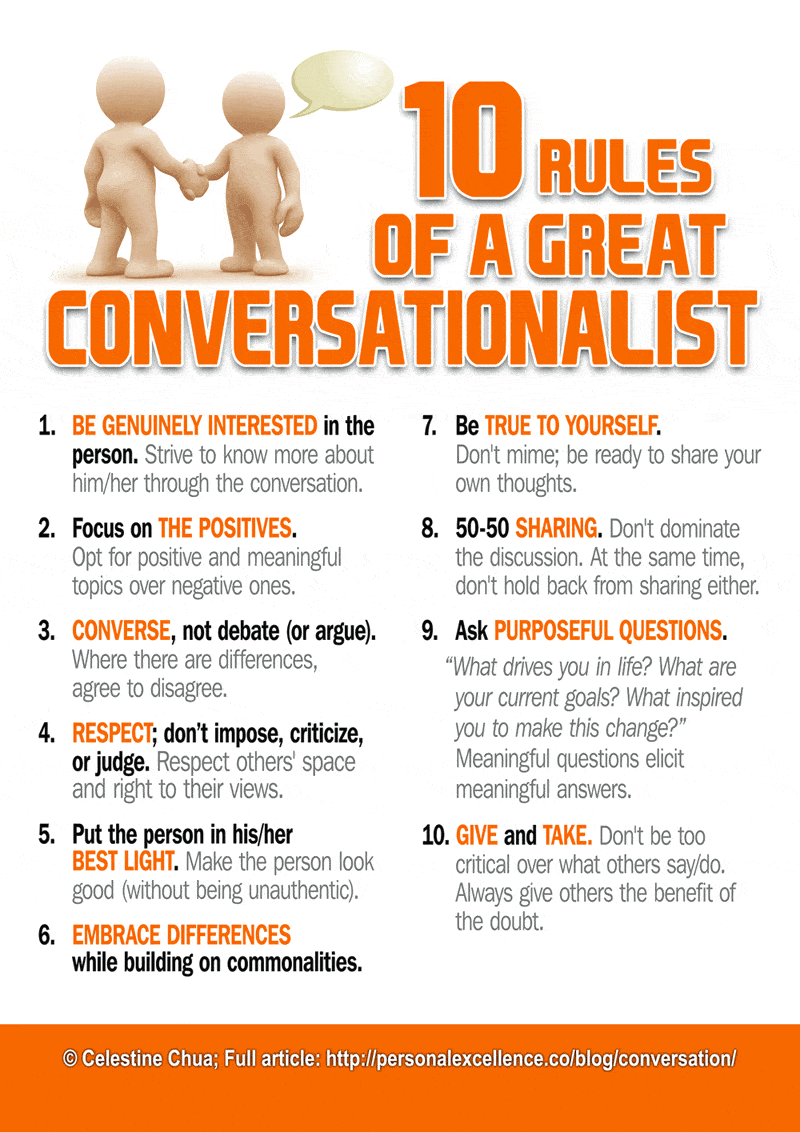Conversational skills help HR—and pretty much anyone else . . .
. . . who wants to go anywhere in any company.
We in HR have a lot of soft skills to use. All. The. Time. And really, it’s not just HR who needs to master the skill of being conversational. It can help any employee—all the way from entry level to CEO—relate to people better and navigate the workplace much easier. After all, when you know how to really talk to people, they can help you find or learn what you need to.
That’s why this infographic on the “10 Rules of a Great Conversationalist” caught my eye. Of course, we need to be well-versed in the art of talking to our people. So, here are Celeste Chua’s 10 tips for making those conversations (the easy and the hard ones) a positive experience:
1. Be genuinely interested in the person. Are you trying to help the person who’s sitting before you? If you could help him, would you? Do you want to see him succeed? These are important questions that will show you just how authentic you are in being interested. Ask questions. Find out why the person is sitting there (sometimes it’s a struggle that pushed them into your office). These details will help you be genuinely interested and care more in helping.
2. Focus on the positives. HR knows that people will often end up in their office to complain or because they’re struggling. Of course we have to be neutral, but that doesn’t mean we can’t try to bring out the positives of every situation. Mediation is often required, but that doesn’t mean we can’t try to bring people around to seeing that the problem isn’t as bad as they think. And we can encourage coworkers to really talk to each other to get at the heart of the problem. At times, focusing on the positives means we redirect the conversation to the meaningful work we’re all doing, rather than the difficulties we may be having.
3. Converse (not debate or argue). Even though people are sometimes worked up when they enter your domain, your job is to make sure you’re having a conversation, not a debate or argument. You need to show you’re on the same side and that you’re in this together, not on opposite sides.
4. Respect; don’t impose, criticize, or judge. The first thing you can do to let the person know you want to help them is to show them respect. Many times, it’s taken a lot of effort for someone to come to you so if you begin criticizing or judging them right away, they’ll feel the need to defend themselves rather than feel that you’re working on solving a problem together.
5. Put the person in his/her best light. You should be able to do this by first knowing the person you’re talking to. What are his or her strengths? First, focus on those and make sure it’s understood that the person is valued and recognized for doing good work.
6. Embrace differences. Every employee, every person is different. We all come with certain strengths and weaknesses, and that’s okay. We’re all on our own paths to improve, and none of our destinations is the same. When talking to an employee, be understanding about those different goals and ways of achieving them.
7. Be true to yourself. You have a lot to offer. You’ve worked with a lot of people and from experience, have valuable stories and advice to provide. Don’t hold back or just say what the person wants to hear. If you could help someone as a result of your experience, don’t be afraid to be upfront. Sometimes what you say may be hard for someone to hear, but when done with good intent and growth in mind, it’s the right thing.
8. 50-50 sharing. A conversation is a two-way street. Sometimes you talk, sometimes you listen. When the sharing is equal, you’ll know you heard enough to truly assess the situation and spoke up enough to know you offered up the best advice you could.
9. Ask purposeful questions. Some of the “speaking up” you should do is asking questions that really get people to think hard. Sometimes it’s difficult for them to come up with answers; sometimes people can’t answer them right away. Some of those tough (but effective) questions include: What do you really want out of your career? What drives you? Why did you do what you did? Was that what you should have done? Some of these questions are difficult to ask—and answer, but it’s important you’re asking them.
10. Give and take. People see things differently and sometimes you may have heard things around the office that are just hearsay. Make sure you listen enough first to get the real story and always, always give people the benefit of the doubt. Then once you know exactly what you’re dealing with, you can give what you can to help with a problem or just offer to help in ways you can.
The fact is that conversation is a necessary part of working with most anyone. During job interviews, working in teams, talking to your boss or employees. You’ll find yourself in many different conversations. Done with thought and correctly, it can be a vehicle to really helping people work through problems or just help them understand more about their careers and life. And frankly, these tips can be helpful in any conversation—at work or not.
Get caught up every month on all things HR. Don't worry, we promise we won't spam you.










